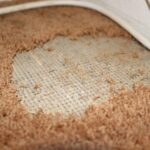A home wouldn’t be a home without a sofa. Whether lounging in the evening watching TV, gathering round with family or friends, as a comfy perch for pets or a place where children can sprawl out, a sofa serves multiple purposes. Being used day-in and day-out does, however, mean that sofas can become one of the dirtiest items in your home. They easily pick up dust, debris, crumbs, stains, body oils, pet dander and allergens like dust mites, turning your treasured couch into an unappealing hotbed of dirt and grime. So, with this in mind, how often should you get your sofa cleaned?
1. The importance of upholstery cleaning
Before getting into the nitty gritty of how often you should get your sofa cleaned, it’s worth thinking about why upholstery cleaning is so important. Many of us recognise the importance of getting our carpets or rugs cleaned, but sofas don’t often get the same level of cleaning attention as our flooring. In fact, according to a Which? survey*, one in ten people have never even had their sofas cleaned. Yet, sofas are one of the most used items in the home, and because we have close contact with them, they are prone to getting dirty fast.
2. Regular upholstery cleaning can help to:
- Remove visible dirt – some parts of a sofa may be susceptible to getting dirty more than others, creating uneven patches and discoloration. For instance, sofa armrests can pick up oils from our forearms, and may be vulnerable to spills from food or drinks held in our hands. Similarly, scuff marks from unclean footwear or skin oils may be noticeable on the front of the couch where legs and feet rest.
- Get rid of invisible substances and particulates that may be trapped in sofa fabrics – as with carpets and rugs. These can include dust mites, bacteria, viruses, germs, and chemicals, which can put you at risk of illnesses.
- Prolong the life of your sofa – by removing dirt from a sofa you can help to prevent it from experiencing fabric damage or degradation, keeping it in a clean, fresh and healthy condition for as long as possible.
- Improve a sofa’s appearance.
- Eliminate odours – it’s not just visible dirt that can taint a sofa. Odours from pets, old or improperly removed stains or damp can make sofas smell unappealing.
3. Cleaning your upholstery
To keep your sofa in the best condition possible, experts recommend that you get your upholstery professionally cleaned approximately once every six months. This is a general guideline, and can be influenced by a number of factors.
For instance, if you have a sofa that gets used a lot, particularly by children and pets, you might need to consider upholstery cleaning more frequently than a sofa that doesn’t get much use. Heavily-used sofas could need deep cleaning as often as three or four times per year. A sofa that’s hardly used, such as one in a spare room, might only need cleaning once per year.
If you eat and drink while sitting on your sofa, it’s inevitable that occasional spillages are going to occur. Immediately blot the spillage and contact a professional upholstery cleaning company, even if your sofa isn’t due for its regular routine deep clean. It’s better to sort a spillage out promptly by experts rather than let the stain set into the sofa, or use shop-bought cleaning products which are usually inferior to those used by professionals.
Light-coloured sofas are also prone to showing dirt more than dark-coloured upholstery, so may require more frequent cleaning care. That said, just because you can’t see dirt in a sofa doesn’t mean to say it’s not there, so choosing a darker shade of settee isn’t a get-out clause for skipping its cleaning!
Different sofa materials might need cleaning more often than others. Leather, for example, is less prone to attracting bacteria and allergens compared to fabric sofas, so might not need as frequent cleaning. However, leather sofas can still look grubby and lose their lustre as time goes by, so still need some expert TLC. Typically, leather sofas will need conditioning about twice per year to keep them glossy and to prevent any small cracks from forming in the material.
There might also be certain times of the year when your sofa gets dirty more often, depending on your lifestyle and who uses your sofa. For example, in summer your couch may have more contact with sweaty skin, oils from sun screen lotion or dead, flaky skin, hastening the need for a deep clean.
4. How to get your sofa cleaned
Although you might be tempted to try to clean your sofa yourself, it’s better to rely on professional upholstery cleaning services. That’s because sofas have different cleaning requirements, depending on their fabrics and materials, shape, design and cut. If you don’t know what you’re doing, you could end up ruining your sofa. Many items of upholstery have cleaning codes on their furniture tags which give you an indication of how they should be cleaned, but even with this knowledge, you’re unlikely to get the same quality of results compared to using a local professional upholstery cleaning company.
Plus, many shop-bought fabric cleaners don’t do a thorough job of removing stains, and might leave sticky residues in your sofa, which could affect its appearance and encourage rapid resoiling.
A professional upholstery cleaning company will use powerful cleaning technology that’s designed to deep clean sofas all over, getting to all the nooks, crannies and corners in a sofa that may have experienced dust and dirt accumulation.
Many sofa cleaning firms, such as our upholstery cleaning London business, also offer a wide range of other cleaning services. So when you’re getting your carpets or rugs booked in for cleaning, remember to include your sofa, too. It will save you time from having to source a separate cleaning company, and you might even get a discount for having multiple items cleaned at once.
Once you’ve had your sofa cleaned, a professional technician will be able to advise you how often your type of sofa needs cleaning again, and what you can do in the meantime to keep it in good condition.
5. Sofa self-care
In addition to using professional upholstery cleaning services around twice per year, you can do your bit to keep your settee in great shape all year round by gently vacuuming it on a weekly basis. This isn’t a substitute for professional cleaning, as vacuuming only removes surface dust, dirt and crumbs, but it should be used in conjunction – just like how you clean your carpets.
When using your hoover, it’s important to clean the main body of the sofa itself, as well as the arms and sides of the frame, the cushions and under the cushions. Pay attention to clean creases and folds in fabrics, where dust can easily accumulate. You can also use a lint roller to remove any dust and debris.
If you have a leather sofa, it’s worth giving it a wipe down every week with a damp cloth. Be careful of using tap water on some types of leather as the minerals can cause staining; use distilled water, instead. For velvet sofas, use a soft, metallic brush in the direction of the fabric pile to remove dust and help the sofa retain its sheen.
Some sofas have removable covers that can be machine washed, which is handy if chairs experience a build up of pet hairs or are prone to getting dirty quickly. Check the care instructions carefully, however, to make sure fabrics don’t shrink.
When the time comes to get your sofa professionally cleaned, give our upholstery cleaning London experts a call for a free, no-obligation quote.
* https://www.which.co.uk/reviews/sofas/article/choosing-a-sofa/how-to-clean-a-sofa-aRTiN9T7jccq







